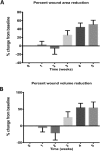Negative Pressure Wound Therapy With Low Pressure and Gauze Dressings to Treat Diabetic Foot Wounds
- PMID: 24876586
- PMCID: PMC4455400
- DOI: 10.1177/1932296813519012
Negative Pressure Wound Therapy With Low Pressure and Gauze Dressings to Treat Diabetic Foot Wounds
Abstract
This study was a prospective cohort study to evaluate negative pressure wound therapy (NPWT) with low pressure and a gauze dressing to treat diabetic foot wounds. Thirty patients with diabetic foot wounds were consented to a prospective study to evaluate wound closure and complications to evaluate NPWT with low pressure (80 mmHg) and a gauze dressing interface (EZCare, Smith and Nephew) for up to 5 weeks. NPWT was changed 3 times a week. Study subjects were evaluated once a week for adverse events and wound measurements. Of study subjects, 43% attained at least a 50% wound area reduction after 4 weeks of therapy. Our results suggest that a high rate of wound closure could be expected with low pressure and a gauze interface.
Keywords: amputation; diabetes; infection; negative pressure; ulceration.
© 2014 Diabetes Technology Society.
Conflict of interest statement
Figures



Similar articles
-
Use of NPWT with and without Soft Port technology in infected foot wounds undergoing partial diabetic foot amputation.J Wound Care. 2015 Sep;24 Suppl 9:S4-S12. doi: 10.12968/jowc.2015.24.Sup9.S4. J Wound Care. 2015. PMID: 26352284
-
OUTCOME OF FOAM VERSUS GAUZE DRESSINGS IN NEGATIVE PRESSURE WOUND THERAPY FOR THE MANAGEMENT OF ACUTE TRAUMATIC WOUNDS WITH SOFT TISSUE LOSS AT KENYATTA NATIONAL HOSPITAL.East Afr Med J. 2012 Jul;89(7):230-40. East Afr Med J. 2012. PMID: 26845802 Clinical Trial.
-
[Negative-pressure wound therapy versus standard wound dressing in the treatment of diabetic foot amputation. A randomised controlled trial].Cir Esp. 2009 Sep;86(3):171-7. doi: 10.1016/j.ciresp.2009.03.020. Epub 2009 Jul 18. Cir Esp. 2009. PMID: 19616774 Clinical Trial. Spanish.
-
Negative pressure wound therapy is associated with up-regulation of bFGF and ERK1/2 in human diabetic foot wounds.Wound Repair Regen. 2014 Jul-Aug;22(4):548-54. doi: 10.1111/wrr.12195. Wound Repair Regen. 2014. PMID: 24809625 Review.
-
Negative-pressure wound therapy for prevention and treatment of surgical-site infections after vascular surgery.Br J Surg. 2017 Jan;104(2):e75-e84. doi: 10.1002/bjs.10403. Epub 2016 Nov 30. Br J Surg. 2017. PMID: 27901277 Review.
Cited by
-
Does complete resection of infected bone improve clinical outcomes in patients with diabetic foot osteomyelitis?Int Wound J. 2024 Oct;21(10):e70072. doi: 10.1111/iwj.70072. Int Wound J. 2024. PMID: 39375181 Free PMC article.
-
Electrospinning strategies targeting fibroblast for wound healing of diabetic foot ulcers.APL Bioeng. 2025 Feb 25;9(1):011501. doi: 10.1063/5.0235412. eCollection 2025 Mar. APL Bioeng. 2025. PMID: 40027546 Free PMC article. Review.
-
Smart self-healing hydrogel wound dressings for diabetic wound treatment.Nanomedicine (Lond). 2025 Apr;20(7):737-754. doi: 10.1080/17435889.2025.2466414. Epub 2025 Feb 18. Nanomedicine (Lond). 2025. PMID: 39964000 Review.
-
Tapering pressure of wall vacuum-assisted closure for the treatment of patients with pancreatic fistula in traumatic pancreatic injury: Report of two cases.Int J Surg Case Rep. 2020;68:158-161. doi: 10.1016/j.ijscr.2020.02.048. Epub 2020 Feb 28. Int J Surg Case Rep. 2020. PMID: 32163905 Free PMC article.
-
Effect of Modified Allgöwer-Donati Suture Technique on Wound Cosmetics in Spinal Surgery.Orthop Surg. 2022 Apr;14(4):678-685. doi: 10.1111/os.13188. Epub 2022 Feb 18. Orthop Surg. 2022. PMID: 35179312 Free PMC article. Clinical Trial.
References
-
- Armstrong DG, Lavery LA. Negative pressure wound therapy after partial diabetic foot amputation: a multicentre, randomised controlled trial. Lancet. 2005;366(9498):1704-10. - PubMed
-
- Blume PA, Walters J, Payne W, Ayala J, Lantis J. Comparison of negative pressure wound therapy using vacuum-assisted closure with advanced moist wound therapy in the treatment of diabetic foot ulcers: a multicenter randomized controlled trial. Diabetes Care. 2008;31(4):631-636. - PubMed
-
- Borgquist O, Ingemansson R, Malmsjo M. The influence of low and high pressure levels during negative-pressure wound therapy on wound contraction and fluid evacuation. Plast Reconstr Surg. 2011;127(2):551-559. - PubMed
-
- Borgquist O, Ingemansson R, Malmsjo M. Wound edge microvascular blood flow during negative-pressure wound therapy: examining the effects of pressures from −10 to −175 mmHg. Plast Reconstr Surg. 2010;125(2):502-509. - PubMed
-
- Borgquist O, Gustafsson L, Ingemansson R, Malmsjo M. Micro- and macromechanical effects on the wound bed of negative pressure wound therapy using gauze and foam. Ann Plast Surg. 2010;64(6):789-793. - PubMed
LinkOut - more resources
Full Text Sources
Other Literature Sources
Medical

